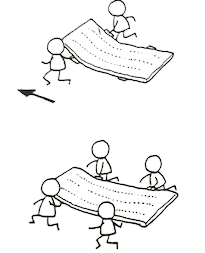Objectives
Children like to touch the soft quilt-like mat to do whole-body exercise, using different methods to enhance children's comprehensive exercise ability, and recognize the names of body parts by touching the mat with each part of the body. We can also learn the names of different parts of the body by touching the mats. We can also cultivate synergy and care for the equipment by arranging the mats together or collecting the mats.
object (of discussion)
For 3-6 year olds, different levels of difficulty are given to each child according to gender and age.
Preparation Equipment
Try to have as many mats as possible, one mat for about 5 people.
Getting Ready to Exercise
Free running around the mat with a whistle, movement of the joints of the hands or feet or jumping to prepare for exercise.
Methods and Developments for 3 year olds in small groups
Approach and start, doubling as a preparatory exercise with free running around the perimeter of the mat.
- Figure 1a: The 3-year-old walks like an animal walks.
- Figure 2a: 3-year-olds lined up around the mat.
- Fig. 3a; 3-year-olds' mats were used as islands to crawl back and forth between two islands or to learn rowing maneuvers or swimming maneuvers back and forth.
Methods and Developments for 4 year olds in the middle class
- Figure 1b: A 4-year-old child uses a part of his body (hand or foot) to touch the mat and recognize the names of body parts.
- Figure 2b: A 4-year-old runs around two mats in two rows and claps his hands for the relay.
- Figure 3b: The 4-year-old used the mat as an island and went back and forth between the two islands in an airplane or boat maneuver.
Toddler Methods and Development in the 5-Year-Old Classroom
- Figure 1c: A 5-year-old child's teacher blows a whistle and calls out the name of a body part that the child uses to touch the mat. The teacher calls the child's name and the child calls out the name of the body part and touches the mat with that part, using as many different parts as possible for each child.
- Figure 2c: 5-year-olds were divided into four rows to run a relay race.
- Figure 3c: The 5-year-old used the mat as an island and swam back and forth between the two mats in a variety of different ways.
- Picture 4: Four people working together to carry the mat for the relay.
- Picture 5: Use the mat to play catch the ghost game, the caught toddler has to stand on the mat.
Guidance Notes
Although the play of 3/4/5 years old is different, but teachers can adjust to the differences in the ability of each child, catching ghosts game teachers can also adjust the distance of the griddle pads to the differences in the ability of children, take the pads of the relay teachers should pay attention to whether the space is large enough to be safe.





